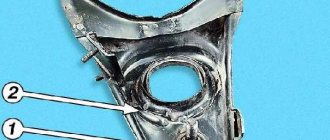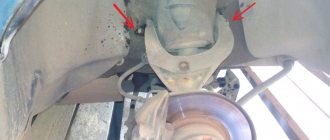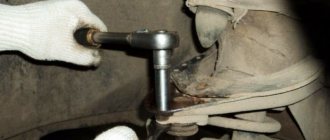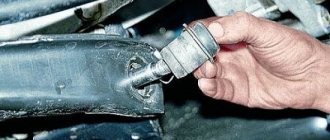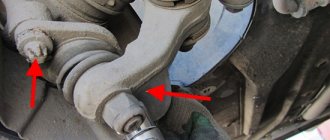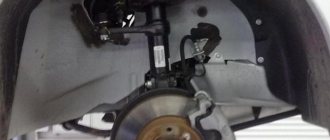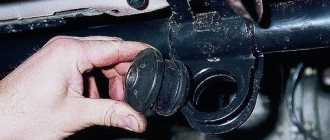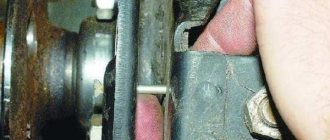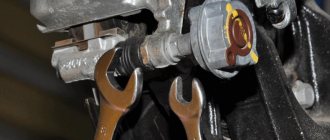VAZ 2107 engine tightening torques
Tightening torque for the cylinder head of the VAZ 2107 engine:
- Tighten the M12SI.25 cylinder head mounting bolt in 2 steps:
- first time - 3.4 - 4.2 kgf/m;
- second time - .9.79 - 12.8 kgf/m.
- M8 bolts for attaching the cylinder head with a force of 2.2–2.73 kgf/m
Tightening torque of the camshaft of the VAZ 2107 engine:
- M8 nut securing the camshaft bearing housing with a force of 1.87-2.31 kgf/m
- Bolts M10S1.25 for camshaft pulleys and oil pump drive shaft - 6.8 - 8.4 kgf/m
- Bolt M10S1.25 for tightening the camshaft sprocket with a torque of 4.2 - 5.2 kgf/m
VAZ 2107 bolt tightening torque:
- Bolt M10S1.25 for the crankshaft main bearing tire ties - 6.97-8.61 kgf/m
- M6 bolts for tightening the oil pan - 0.52-0.85 kgf/m
Tightening torque of VAZ 2107 engine connecting rods:
- Connecting rod cover bolt nut - 4.42-5.46 kgf/m
VAZ 2107 flywheel tightening torque:
- Flywheel connection bolt M10S1.25 - 6.22-8.92 kgf/m
CARBURETOR VAZ 2107
| VAZ engine tightening torque table | ||
| Name of propulsion devices and parts | Thread | VAZ 2107 engine tightening torques, kgf/m |
| Breather cover tie rod | M8 | 1,3-2.1 |
| Breather cover nut | M8 | 1,3—2,1 |
| Nut for fastening the inlet and outlet pipelines | M8 | 2,13-2,63 |
| Bslt tension roller mounting* | M8 | 2,5-3,5 |
| Bolt for attaching the chain tensioner shoe VAZ 2107 | M10S1.25 | 4,2—5,2 |
| Camshaft bearing housing stud nut | M8 | 1,87-2,31 |
| Bolt for attaching the oil pump drive shaft sprocket | M10S1.25 | 4,2-5,2 |
| Adjusting bolt nut | М12S1.25 | 4,42-5,46 |
| Bolts for camshaft pulleys and oil pump drive shaft* | М10S1.25 | 6,8-8,4 |
| Valve adjusting bolt bushing | М18S1.5 | 8,5—10,5 |
| Spark plug | М14S1.25 | 3,13—3,99 |
| Coolant pump attachment bolt | M8 | 2,21-2,73 |
| Nut of the stud fastening the exhaust pipe of the cooling jacket | M8 | 1,63—2,31 |
| Crankshaft ratchet | M20S1.5 | 10,3-12,8 |
| Magneto bracket fastening dowel | M10S1.25 | 4,5—6,6 |
| Nut ghb fastening the generator mounting plate | M10S1.25 | 2,86-4,62 |
| Nut securing the generator to the bracket | M12S1.25 | 5.95-7.35 |
| Nut securing the mounting plate to the generator | M10S1.25 | 2.86-4.62 |
| Nut for attaching the pillow to the front support bracket | M10S1.25 | 2.21-3.57 |
| Nut connecting the engine front suspension cushion to the cross member | M10S1.25 | 2.8-3.46 |
| Nut binding plate to pillow | M6 | 0.58-0.94 |
| Nut securing the rear engine suspension to the body | M8 | 1.53-1.9 |
| Nut securing the rear support to the gearbox | M8 | 2.38-2.94 |
| Nut of the bolt securing the rear support to the cross member | M8 | 1.62-2.62 |
| Sensor for connecting an electric fan | M22S1.5 | 4.8-5.04 |
Why silent blocks fail
When encountering failures of silent blocks for the first time, it is quite difficult to imagine what can happen to these products after long-term use. Over time, the rubber begins to tear, resulting in the need to replace the hinge.
There may be several reasons why a product becomes unusable:
- High mileage of the car, the consequence of which was the drying out of the rubber, loss of its elasticity and the appearance of cracks and tears.
- Contact of chemicals with the rubber of the silent block. Since the suspension element in question is located near the engine, it is likely that it will be exposed to oil, which leads to the destruction of the rubber.
- Incorrect installation. Fastening the bolts of the levers should only be done after the car is installed on the wheels and not hung on a lift. If tightened incorrectly, the rubber of the silent block becomes strongly twisted, which leads to rapid failure of the product.
Clutch tightening torques for VAZ 2107
VAZ clutch basket tightening torque
- Bolt for attaching the clutch basket to the M8 flywheel with a force of 1.95-3.15 kgf/m
| List of clutch devices and parts | Thread | Tightening torque of clutch parts VAZ 2107, kgf/m |
| Nut of the bolt connecting the clutch and 19.6 (2.0) 12.7 (1.3) 20.6 (2.1) brakes | М12S1.25 | 1,3-2.1 |
| Nut for attaching clutch and brake master cylinders | M8 | 1,0-1,6 |
| Connection of hydraulic brake pipes | M10 | 1,5-1,9 |
| Connecting hydraulic clutch pipes | M12 | 2,5-3,2 |
Healthy ! Generator VAZ 2107
Checking silent blocks
It would be a good idea for the owners of the “Seven” to know how to determine that the silent blocks need to be replaced. High-quality products last for quite a long time - up to 100 thousand km. However, due to the condition of our roads, the need to replace them usually arises after 50 thousand km. You can determine that the rubber joints have become unusable by how you feel while driving the car. If the car begins to handle worse, the steering wheel is no longer as responsive as before, then this indicates obvious wear and tear on the silent blocks. To be more confident, it is recommended to visit a service station so that specialists can diagnose the suspension.
If visible signs of wear appear, the part needs to be replaced.
The condition of silent blocks can be determined independently by visual inspection. To do this, you will need to drive the car onto an overpass or inspection hole, and then inspect each of the hinges. The rubber part should not have cracks or tears. One of the signs of failure of silent blocks is a violation of wheel alignment. In addition, a sign of wear on the part in question is uneven wear on the tire tread. This phenomenon indicates an incorrectly adjusted wheel alignment, which may be causing the vehicle's suspension to malfunction.
There is no point in delaying the replacement of silent blocks, since over time the seats in the levers become broken, so the lever assembly may need to be replaced.
Tightening torques for the VAZ 2107 gearbox
| List of devices and parts of the motor | Thread | Tightening torque of VAZ 2107 gearbox parts, kgf/m |
| Reversing light connector | M14S1.5 | 2,9-4,6 |
| Bolts connecting the clutch housing to the engine | М12Sх1.5 | 5,5-8,9 |
| Nut securing the clutch housing to the gearbox | M10S1.25 | 3,25-5,25 |
| Nut connecting the clutch housing to the gearbox | M8 | 1,6-2,6 |
| Bolt for attaching the rod clamp cover | M8 | 1,6-2.6 |
| Rear cover connection nut | M8 | 1,6-2,6 |
| Nut of the rear end of the driven shaft | M20S1 | 6,8-8.4 |
| Intermediate Shaft Bearing Clamp Washer Bolt | M12S1.25 | 8,1-10 |
| Bolt securing the fork to the gear selector rod | M6 | 1,2-1,9 |
Do-it-yourself silent block puller
To replace silent blocks on cars of the VAZ 2101-2107 family, there is no need to buy the appropriate puller; you can do without it, especially since it costs money. But with such a device it is much easier to carry out planned repair work.
It’s quite possible to assemble a silent block remover with your own hands at home, and for this you only need a few parts:
M12 bolt with fine thread, the length of which is at least 7 cm.
A piece of pipe has the following dimensions: length 3 cm, internal diameter 40 mm, and external diameter 50 mm.
Washer with an outer diameter of 50 mm minimum.
Two pieces of pipe with the following dimensions: length 10 cm and diameter 40 mm.
Do-it-yourself silent block puller
When all the components for implementing a homemade puller are ready, you can begin to implement the idea:
Increase the internal diameter of the pipe from 40 mm to 45 mm.
To use the device to press out old hinges, you will need to put a washer on it.
The bolt must be placed inside the device, and then a large-diameter mandrel must be placed on the outside. This mandrel will rest against the wall of the lever. To press the part, you will need to put on the washer and screw the nut.
The device can be made at home using improvised materials, which is what many actually do. Implementing such an idea will not be difficult, but you can significantly save money on purchasing a factory puller.
Tightening torques for the VAZ 2107 driveshaft
| List of devices and parts | Thread | Tightening torque of VAZ 2107 parts, kgf/m |
| Front propeller shaft fork nut | M16S1.5 | 8,1-10.0 |
| Nuts of bolts for attaching the elastic coupling | М12Sх1.25 | 5,9-7,3 |
| Nuts of bolts connecting the propeller shaft flange to the gearbox flange | M8 | 2,8-3,5 |
What are silent blocks?
In addition to the purpose of silent blocks, you need to know that these products can be made of rubber or polyurethane. It is generally accepted that replacing rubber suspension components with polyurethane ones, where possible, will only improve the characteristics and performance of the suspension.
Silent blocks made of polyurethane are characterized by a longer service life, unlike rubber ones.
The disadvantage of polyurethane elements is their high cost - they are about 5 times more expensive than rubber ones. When installing polyurethane products on a VAZ 2107, you can improve the car's behavior on the road, reduce deformations in the suspension, and also eliminate the so-called squeezing, which is characteristic of rubber elements. This means that the suspension will operate in the condition intended by the designers at the factory. With the correct selection and installation of polyurethane parts, noise and vibration are reduced and shocks are absorbed, which indicates the better performance of such hinges compared to rubber ones.
Silent blocks made of polyurethane are considered more reliable than rubber ones, but are much more expensive
Tightening torques for the rear axle VAZ 2107
Tightening torques for the VAZ 2107 gearbox:
- Bolts M8S1.25 for fastening the gearbox - 3.57-4.41 kgf/m
Tightening torque for the VAZ 2107 shank:
- The tightening torque of the M16S1.5 shank nut is -117…225N • m (12…26 kgf • m)
| List of devices and parts | Thread | Tightening torque of VAZ 2107 parts, kgf/m |
| Differential bearing cover bolts | М10Sх1.25 | 4,42-5,46 |
| Driven gear connection bolts | М10Sх1.25 | 8.5-10.5 |
| Nuts of the axle bearing and brake shield fastening plate | M10S1.25 | 4.25-5-25 |
Preparatory work
The first thing to do is remove the air filter. For those who have a carburetor VAZ, the process is not difficult. With injection models you will have to tinker a little longer.
To gain access to the cylinder head, you need to completely dismantle the part of the fuel system located in the engine compartment.
It is better to remove the carburetor completely, since removing the cylinder head with it is a rather labor-intensive procedure, as a result of which one of the components is often damaged.
After this, unscrew the nut holding the distributor - it and the cables are removed. Sometimes the fastener does not give way. It is not difficult to break its tightness by treating the fastener with WD-40 and leaving it alone for a couple of minutes.
At this point, disassembly is stopped, since it is necessary to drain the coolant - place a container under the fitting located on the bottom and unscrew its plug
After this, slowly (this is important) unscrew the cap from the distribution tank. When the antifreeze pours out, proceed to dismantling the cylinder head casing
Use a socket wrench for this. Place the loosened nuts and spring washers in a box so as not to lose them.
When the antifreeze has poured out, proceed to dismantling the cylinder head casing. Use a socket wrench for this. Place the loosened nuts and spring washers in a box so as not to get lost.
Now all that remains is to remove the head and install a new gasket. We won’t dwell on this point – there is nothing complicated here.
Tightening torques for threaded connections of the front suspension of VAZ 2107
VAZ 2107 wheel tightening torque:
- Wheel attachment bolt M12S1.25 with a force of 6.0-7.35 kgf/m
Tightening torque of the nuts of the levers VAZ 2107 kgf/m:
- Nut of the lower bolts for attaching the cross member to the body spar M12SI.25 - 6.8-8.4;
- Nut M12X1.25 for the lower arm axis fastening bolt - 6.8-8.4;
- Nut M14S1.5 of the lower arm axle - 6.5-10.5.
| Name of devices and parts | Thread | Tightening torque of threaded connections, kgf/m |
| Bolts connecting the cross member to the body side member | M12S1.25 | 8,0-10 |
| Upper arm axle nut | M14S1.5 | 5,85-9,4 |
| Nut connecting the upper end of the shock absorber | M10S1.25 | 2.8-3,46 |
| Nut for attaching the lower end of the shock absorber | M10S1.25 | 5,1-6,3 |
| Front wheel hub bearing nut | M18S1.5 | see section chassis |
| Bolt attaching the caliper to the bracket | M10S1.25 | 3,0-3,7 |
| Anti-roll bar connection nut | M8 | 1,53-1,9 |
| Nut for attaching ball pins to the steering knuckle | M14S1.5 | 8.5-10,5 |
| Steering knuckle bolt nut | М10S1.25 | 5.1-6.3 |
Healthy ! Fuse box VAZ 2107
Replacing the front wheel bearing
Work on replacing a wheel bearing begins with the preparation of tools and materials. You will need:
- set of socket wrenches;
- screwdriver;
- chisel;
- hammer;
- pliers;
- extension for knocking out the bearing race;
- new bearing, seal and lubricant;
- rags;
- kerosene.
How to remove
To dismantle the part, lift the front wheel using a jack. In a service station, work is carried out on a lift. When replacing a bearing, the following sequence of actions must be performed:
- Unscrew the fasteners and remove the wheel.
- Unscrew the fastening and dismantle the caliper.
To avoid damage to the brake hose after removing the caliper, the latter is carefully suspended and secured with wire.
How to put
After dismantling the wheel bearings and cleaning the hub itself, you can begin installing new parts. The work is performed in the following order:
Instructions
The hydraulic silent block puller is universal. It can be used to perform both device removal and pressing. It’s not difficult to make such a mechanism - just a few parts and a couple of hours of time are enough, but you can use it every time you repair suspension parts.
So, the tools that will be needed to produce a puller are: a motorist’s kit with many keys and screwdrivers, a small piece of strong metal pipe with a diameter that is slightly larger than the silent block taken, several large steel washers, a long bolt with high-quality threads, special clothing and construction gloves.
The work progress should be as follows:
- We study the entire structure of the car and in particular its suspension. We look at the new and old part, analyze their structure and try to understand how best to use the puller.
- On one side of the prepared pipe we insert a silent block, which should be replaced according to plan, and on the other side of the pipe we insert a new mechanism. The scheme of work is to squeeze out the old one with a new part (this way neither one nor the other will be damaged).
- We direct the new silent block 100% exactly into the seat, take the prepared bolt and screw it to the center. The initial screwing may be a little heavy, in which case it may be worth tapping the pieces with a hammer a little and continuing with the process. Starting from the middle, this bolt will go in so easily that you can turn it with two fingers. But perform this process only with gloves so as not to damage the limbs.
- If you want to save the old part, then such a puller does not provide for this process and the worn part may simply fall onto the sand. Therefore, you can additionally build a small stand that will perform this function. This could be a simple cup with wire-shaped metal handles or some other device.
There are other methods and improvised means that can serve as a removable mechanism. When creating such a device with your own hands, consider what is present in your garage and which of these is least necessary. It is these details that can be used. Analyze and turn on your thinking - something will immediately come to mind.
It is worth understanding that depending on which beam of the car is being repaired, there may be a different silent block, but the instructions for creating a puller described above will be suitable for different types of devices and can be used for both the rear and the front.
When creating a device, it is worth remembering that a certain car model has its own parameters and parts, which may be different in structure and size. It is important to take into account all the features of the car so that the created puller is suitable and can work with this device.
At the end of the article, I would like to note that a working silent block helps the car drive smoothly, without unnecessary vibrations. It can remove vibrations that emanate from one part of the machine to another quite well, thereby making movement more comfortable. A caring driver always monitors the condition of the car’s suspension, so adjacent parts are very important to him. It is not so difficult to make a puller for silent blocks with your own hands, so try to make it from scrap materials - this way you will save a lot of money. Good luck in job!
